Forensic Geology Applied to Decipher the Landslide Dam Collapse and Outburst Flood of the Santa Cruz River (12 November 2005), San Juan, Argentina
Abstract
1. Introduction
1.1. The Forensic Geology Concept
1.2. The Santa Cruz River Jökulhlaup
2. Description
2.1. Flow 1
2.1.1. Flow 1 Beginning
2.1.2. Flow 1 Transport
2.1.3. Flow 1 Deposit
2.1.4. Flow 1 Post-Deposition Alteration
2.2. Flow 2
2.2.1. Flow 2 Beginning
2.2.2. Flow 2 Transport
2.2.3. Flow 2 Deposit
2.2.4. Flow 2 Post-Depositional Alterations
3. Interpretation
3.1. Flow 1
3.2. Flow 2
4. Discussion
4.1. The Dam Collapse
4.2. Impacts of Alternative Interpretations on Remediation and Prevention
4.2.1. Remediation
4.2.2. Prevention
4.2.3. Memory
5. Concluding Remarks
Author Contributions
Funding
Institutional Review Board Statement
Informed Consent Statement
Data Availability Statement
Acknowledgments
Conflicts of Interest
References
- Ruffell, A. Forensic Pedology, Forensic Geology, Forensic Geoscience, Geoforensics and Soil Forensics. Forensic Sci. Int. 2010, 202, 9–12. [Google Scholar] [CrossRef] [PubMed]
- Murray, R.C. Geologist as Private Eye. Nat. Hist. 1975, 84, 22. [Google Scholar]
- Murray, R.C.; Tedrow, J.C. Forensic Geology: Earth Sciences and Criminal Investigation; Rutgers University Press: New Brunswick, NJ, USA, 1975. [Google Scholar]
- Murray, R.C. Evidence from the Earth: Forensic Geology and Criminal Investigation, 1st ed.; Mountain Press Publishing Company: Missoula, MT, USA, 2004. [Google Scholar]
- Pye, K.; Croft, D.J. Forensic Geoscience: Principles, Techniques and Applications; Geological Society of London: London, UK, 2004. [Google Scholar]
- Pye, K. Geological and Soil Evidence: Forensic Applications, 1st ed.; CRC Press: Boca Raton, FL, USA, 2007. [Google Scholar]
- Costa, J.E.; Schuster, R.L. The Formation and Failure of Natural Dams. GSA Bull. 1988, 100, 1054–1068. [Google Scholar] [CrossRef]
- D’Odorico Benites, P.E.; Pérez, D.J.; Sequeir, N.; Fauqué, L. Landslide Dam and Outburst of the Río Santa Cruz, Main Andes, (31°40′ S), Province of San Juan. Rev. Asoc. Geológica Argent. 2009, 65, 713–724. [Google Scholar]
- Perucca, L.; Esper, Y. El Deslizamiento de Rocas y Detritos Sobre el Río Santa Cruz y el Aluvión Resultante Por el Colapso del Dique Natural, Andes Centrales de San Juan. Rev. Asoc. Geológica Argent. 2009, 65, 571–585. [Google Scholar]
- Perucca, L.P.; Angillieri, M.Y.E. Evolution of a Debris-Rock Slide Causing a Natural Dam: The Flash Flood of Río Santa Cruz, Province of San Juan—12 November 2005. Nat. Hazards 2009, 50, 305–320. [Google Scholar] [CrossRef]
- D’odorico, P.E.; Pérez, D.J.; Sequeira, N.; Fauqué, L. El Represamiento y Aluvión del Río Santa Cruz, Andes Principales (31°40′ S), Provincia de San Juan. Rev. Asoc. Geológica Argent. 2009, 65, 713–724. [Google Scholar]
- Penna, I.; Daicz, S.; Zlotnik, S.; Derron, M.-H.; Jaboyedoff, M. Natural Dam Failure in the Eastern Slope of the Central Andes of Argentina. Numerical Modelling of the 2005 Santa Cruz River Outburst Flood. Geophys. Res. Abstr. 2012, 14, 3368. [Google Scholar]
- Penna, I.M.; Derron, M.-H.; Volpi, M.; Jaboyedoff, M. Analysis of past and future dam formation and failure in the Santa Cruz River (San Juan province, Argentina). Geomorphology 2013, 186, 28–38. [Google Scholar] [CrossRef]
- Baldis, C.T.; Liaudat, D.T. Rockslides and rock avalanches in the Central Andes of Argentina and their possible association with permafrost degradation. Permafr. Periglac. Process. 2019, 30, 330–347. [Google Scholar] [CrossRef]
- Sepúlveda, S.; Moreiras, S. Large Volume Landslides in the Central Andes of Chile and Argentina (32–34° S) and Related Hazards. Bull. Eng. Geol. Environ. 2013, 6, 287–294. [Google Scholar] [CrossRef]
- Moreiras, S.M.; Coronato, A. Landslide Processes in Argentina. In Developments in Earth Surface Processes; Elsevier: Amsterdam, The Netherlands, 2009; Volume 13, pp. 301–332. ISBN 978-0-444-53117-9. [Google Scholar]
- Zheng, H.; Shi, Z.; Shen, D.; Peng, M.; Hanley, K.J.; Ma, C.; Zhang, L. Recent Advances in Stability and Failure Mechanisms of Landslide Dams. Front. Earth Sci. 2021, 9, 659935. [Google Scholar] [CrossRef]
- Thorarinsson, S. Some New Aspects of the Grímsvötn Problem. J. Glaciol. 1953, 2, 267–275. [Google Scholar] [CrossRef]
- Hermanns, R.L.; Hewitt, K.; Strom, A.; Evans, S.G.; Dunning, S.A.; Scarascia-Mugnozza, G. The Classification of Rockslide Dams. In Natural and Artificial Rockslide Dams; Springer: Berlin/Heidelberg, Germany, 2011; pp. 581–593. [Google Scholar]
- Milana, J.P. Molards and Their Relation to Landslides Involving Permafrost Failure. Permafr. Periglac. Process. 2015, 27, 271–284. [Google Scholar] [CrossRef]
- Morino, C.; Conway, S.J.; Sæmundsson, Þ.; Helgason, J.K.; Hillier, J.; Butcher, F.; Balme, M.R.; Jordan, C.; Argles, T. Molards as an indicator of permafrost degradation and landslide processes. Earth Planet. Sci. Lett. 2019, 516, 136–147. [Google Scholar] [CrossRef]
- Angillieri, M.Y.E. Permafrost distribution map of San Juan Dry Andes (Argentina) based on rock glacier sites. J. South Am. Earth Sci. 2017, 73, 42–49. [Google Scholar] [CrossRef]
- Heim, A. Bergsturz und Menschenleben; Fretz und Wasmuth Verlag: Zürich, Switzerland, 1932. [Google Scholar]
- Hsü, K.J.; Voight, B. Albert Heim: Observations on Landslides and Relevance to Modern Interpretations. Nat. Phenom. 1978, 1, 70–93. [Google Scholar]
- Hsü, K.J. Catastrophic Debris Streams (Sturzstroms) Generated by Rockfalls. GSA Bull. 1975, 86, 129–140. [Google Scholar] [CrossRef]
- Pollet, N.; Schneider, J.-L. Dynamic disintegration processes accompanying transport of the Holocene Flims sturzstrom (Swiss Alps). Earth Planet. Sci. Lett. 2004, 221, 433–448. [Google Scholar] [CrossRef]
- Scheidegger, A.E. On the prediction of the reach and velocity of catastrophic landslides. Rock Mech. Rock Eng. 1973, 5, 231–236. [Google Scholar] [CrossRef]
- Davies, T.R.H. Spreading of rock avalanche debris by mechanical fluidization. Rock Mech. Rock Eng. 1982, 15, 9–24. [Google Scholar] [CrossRef]
- Davies, T.R.; McSaveney, M.J.; Hodgson, K.A. A Fragmentation-Spreading Model for Long-Runout Rock Avalanches. Can. Geotech. J. 1999, 36, 1096–1110. [Google Scholar] [CrossRef]
- Davies, T.R.; McSaveney, M.J. Dynamic simulation of the motion of fragmenting rock avalanches. Can. Geotech. J. 2002, 39, 789–798. [Google Scholar] [CrossRef]
- Rapp, A. Avalanche Boulder Tongues in Lappland: Descriptions of Little-Known Forms of Periglacial Debris Accumulations. Geogr. Ann. 1959, 41, 34–48. [Google Scholar] [CrossRef]
- Jomelli, V.; Pech, P. Effects of the Little Ice Age on avalanche boulder tongues in the French Alps (Massif des Ecrins). Earth Surf. Process. Landforms 2004, 29, 553–564. [Google Scholar] [CrossRef]
- Potter, N., Jr. Activity of Avalanches, Northern Absaroka Mountains, Wyoming. In United States Contributions to Quaternary Research; Papers Presented on the Occasion of the VIII Congress of the International Association for Quaternary Research; Geological Society of America: Paris, France, 1969; Volume 123, p. 141. [Google Scholar]
- Luckman, B.H. Geomorphic Work of Snow Avalanches in the Canadian Rocky Mountains. Arct. Alp. Res. 1978, 10, 261. [Google Scholar] [CrossRef]
- Luckman, B.H. Debris Flows and Snow Avalanche Landforms in the Lairig Ghru, Cairngorm Mountains, Scotland. Geogr. Ann. Ser. A Phys. Geogr. 1992, 74, 109–121. [Google Scholar] [CrossRef]
- Gardner, J. Geomorphic Significance of Avalanches in the Lake Louise Area, Alberta, Canada. Arct. Alp. Res. 1970, 2, 135. [Google Scholar] [CrossRef]
- Huber, T.P. The geormorphology of subalpine snow avalanche runout zones: San juan mountains, colorado. Earth Surf. Process. Landforms 1982, 7, 109–116. [Google Scholar] [CrossRef]
- André, M.-F. Frequency of Debris Flows and Slush Avalanches in Spitsbergen: A Tentative Evaluation from Lichenometry. Pol. Polar Res. 1990, 11, 345–363. [Google Scholar]
- André, M.-F. Geomorphic impact of spring avalanches in Northwest Spitsbergen (79° N). Permafr. Periglac. Process. 1990, 1, 97–110. [Google Scholar] [CrossRef]
- Hauser, A. Rock Avalanche and Resulting Debris Flow in Estero Parraguirre and Rio Colorado, Regio’n Metropolitana, Chile. Catastrophic landslides: Effects, occurrence and mechanisms. Geol. Soc. Am. Rev. Eng. Geol. 2002, 15, 135–148. [Google Scholar]
- Dramis, F.; Govi, M.; Guglielmin, M.; Mortara, G. Mountain permafrost and slope instability in the Italian Alps: The Val Pola Landslide. Permafr. Periglac. Process. 1995, 6, 73–81. [Google Scholar] [CrossRef]
- Blikra, L.H.; Nemec, W. Postglacial colluvium in western Norway: Depositional processes, facies and palaeoclimatic record. Sedimentology 1998, 45, 909–959. [Google Scholar] [CrossRef]
- Luckman, B.H. The Geomorphic Activity of Snow Avalanches. Geogr. Ann. Ser. A Phys. Geogr. 1977, 59, 31. [Google Scholar] [CrossRef]
- Gnyawali, K.R.; Xing, A.; Zhuang, Y. Dynamic analysis of the multi-staged ice–rock debris avalanche in the Langtang valley triggered by the 2015 Gorkha earthquake, Nepal. Eng. Geol. 2019, 265, 105440. [Google Scholar] [CrossRef]
- Hungr, O.; Evans, S.G. Entrainment of debris in rock avalanches: An analysis of a long run-out mechanism. Geol. Soc. Am. Bull. 2004, 116, 1240–1252. [Google Scholar] [CrossRef]
- Evans, S.G.; DeGraff, J.V. Catastrophic Landslides: Effects, Occurrence, and Mechanisms; Geological Society of America: Boulder, CO, USA, 2002; Volume 15, ISBN 978-0-8137-4115-4. [Google Scholar]
- Anacona, P.I.; Mackintosh, A.; Norton, K.P. Hazardous Processes and Events from Glacier and Permafrost Areas: Lessons from the Chilean and Argentinean Andes: Glacier and Permafrost Hazards in the Extratropical Andes. Earth Surf. Process. Landforms 2015, 40, 2–21. [Google Scholar] [CrossRef]
- Patton, A.I.; Rathburn, S.L.; Capps, D.M. Landslide response to climate change in permafrost regions. Geomorphology 2019, 340, 116–128. [Google Scholar] [CrossRef]
- Has, B.; Noro, T.; Maruyama, K.; Nakamura, A.; Ogawa, K.; Onoda, S. Characteristics of earthquake-induced landslides in a heavy snowfall region—Landslides triggered by the northern Nagano prefecture earthquake, 12 March 2011, Japan. Landslides 2012, 9, 539–546. [Google Scholar] [CrossRef]
- Yamasaki, S.; Nagata, H.; Kawaguchi, T. Long-traveling landslides in deep snow conditions induced by the 2011 Nagano Prefecture earthquake, Japan. Landslides 2013, 11, 605–613. [Google Scholar] [CrossRef]
- Schneider, D.; Kaitna, R.; Dietrich, W.; Hsu, L.; Huggel, C.; McArdell, B. Frictional behavior of granular gravel–ice mixtures in vertically rotating drum experiments and implications for rock–ice avalanches. Cold Reg. Sci. Technol. 2011, 69, 70–90. [Google Scholar] [CrossRef]
- Evans, S.G.; Mugnozza, G.S.; Strom, A.; Hermanns, R.L.; Ischuk, A.; Vinnichenko, S. Landslides from Massive Rock Slope Failure (Nato Science Series: IV); Springer: Berlin/Heidelberg, Germany, 2006; Volume 49. [Google Scholar] [CrossRef]
- Milana, J.P. Predicción de Caudales de Ríos Alimentados Por Deshielo Mediante Balances de Energía: Aplicación en Los Andes Centrales, Argentina. Rev. Asoc. Argent. Sedimentol. 1998, 5, 53–69. [Google Scholar]
- Dufresne, A.; Bösmeier, A.; Prager, C. Sedimentology of rock avalanche deposits—Case study and review. Earth-Sci. Rev. 2016, 163, 234–259. [Google Scholar] [CrossRef]
- Janke, J.R.; Bellisario, A.C.; Ferrando, F.A. Classification of debris-covered glaciers and rock glaciers in the Andes of central Chile. Geomorphology 2015, 241, 98–121. [Google Scholar] [CrossRef]
- Ayala, A.; Pellicciotti, F.; MacDonell, S.; McPhee, J.; Vivero, S.; Campos, C.; Egli, P. Modelling the hydrological response of debris-free and debris-covered glaciers to present climatic conditions in the semiarid Andes of central Chile. Hydrol. Process. 2016, 30, 4036–4058. [Google Scholar] [CrossRef]
- Nagai, H.; Fujita, K.; Nuimura, T.; Sakai, A. Southwest-facing slopes control the formation of debris-covered glaciers in the Bhutan Himalaya. Cryosphere 2013, 7, 1303–1314. [Google Scholar] [CrossRef]
- Jiskoot, H. Long-runout rockslide on glacier at Tsar Mountain, Canadian Rocky Mountains: Potential triggers, seismic and glaciological implications. Earth Surf. Process. Landforms 2011, 36, 203–216. [Google Scholar] [CrossRef]
- Milana, J.P. Hielo y Desierto: Los Glaciares Áridos de San Juan; Elite Ediciones: San Juan, Argentina, 2010. [Google Scholar]
- Espizua, L.E.; Bengochea, J.D. Surge of Grande Del Nevado Glacier (Mendoza, Argentina) in 1984: Its Evolution through Satellite Images. Geogr. Ann. Ser. A Phys. Geogr. 1990, 72, 255–259. [Google Scholar] [CrossRef]
- Rapp, A. Recent Development of Mountain Slopes in Kärkevagge and Surroundings, Northern Scandinavia. Geogr. Ann. 1960, 42, 65–200. [Google Scholar]
- Peev Christo, D. Die Nivation Als Faktor Der Lawinenerosion. Mitt. Oesterreichischen Geogr. Ges. 1961, 103, 267–270. [Google Scholar]
- Allix, A. Avalanches. Geogr. Rev. 1924, 14, 519–560. [Google Scholar] [CrossRef]
- Veyret, P. L’eau, La Neige, La Glace, Le Gel et La Structure Dans l’évolution Morphologique de La Région de Chamonix (Massifs Du Mont Blanc et Des Aiguilles Rouges). Rev. Géographie Alp. 1959, 47, 5–36. [Google Scholar] [CrossRef]
- Peev, C.D. Geomorphic Activity of Snow Avalanches. In International Symposium on Scientific Aspects of Snow and Ice Avalanches; International Association of Scientific Hydrology: Gentbrugge, Belgique, 1966; Volume 69, pp. 357–368. [Google Scholar]
- Mokievsky-Zubok, O. Sudden Flood and Sorted Debris over the Winter Snowpack within Sentinel Glacier Basin, British Columbia. Can. J. Earth Sci. 1975, 12, 873–879. [Google Scholar] [CrossRef]
- Baggio, T.; Mergili, M.; Pudasaini, S.; Carter, S.; Fischer, J.-T. Simulating Snow Process Chains: Avalanche-River Interactions with r.Avaflow; International Snow Science Workshop: Innsbruck, Austria, 2018; pp. 792–796. [Google Scholar]
- Xia, Z.; Woo, M.-K. Theoretical analysis of snow-dam decay. J. Glaciol. 1992, 38, 191–199. [Google Scholar] [CrossRef][Green Version]
- Sharaf, D.; Janes, M. The Evolution of the 2014 ’Damalanche’ Facet Layer in South-Central and SouthEast Alaska. In Proceedings of the International Snow Science Workshop, Banff, AB, Canada, 29 September 2014; pp. 55–62. [Google Scholar]
- Butler, D.; Butler, D.R. Snow-Avalanche Dams and Resultant Hazards in Glacier National Park, Montana. Northwest Sci. 1989, 63, 109–115. [Google Scholar]
- Croce, F.A.; Milana, J.P. Internal structure and behaviour of a rock glacier in the Arid Andes of Argentina. Permafr. Periglac. Process. 2002, 13, 289–299. [Google Scholar] [CrossRef]
- Miller, D.J. Giant Waves in Lituya Bay, Alaska. US Geol. Surv. Prof. Pap. 1961, 354, 51–86. [Google Scholar]
- Waldmann, N.; Vasskog, K.; Simpson, G.; Chapron, E.; Støren, E.W.N.; Hansen, L.; Loizeau, J.-L.; Nesje, A.; Ariztegui, D. Anatomy of a Catastrophe: Reconstructing the 1936 Rock Fall and Tsunami Event in Lake Lovatnet, Western Norway. Front. Earth Sci. 2021, 9, 671378. [Google Scholar] [CrossRef]
- King, W.D.V.O. The Mendoza River Flood of 10–11 January 1934—Argentina. Geogr. J. 1934, 84, 321. [Google Scholar] [CrossRef]
- Bruce, R.; Cabrera, G.; Leiva, J.; Lenzano, L. The 1985 surge and ice dam of Glaciar Grande del Nevado del Plomo, Argentina. J. Glaciol. 1987, 33, 131–132. [Google Scholar] [CrossRef][Green Version]
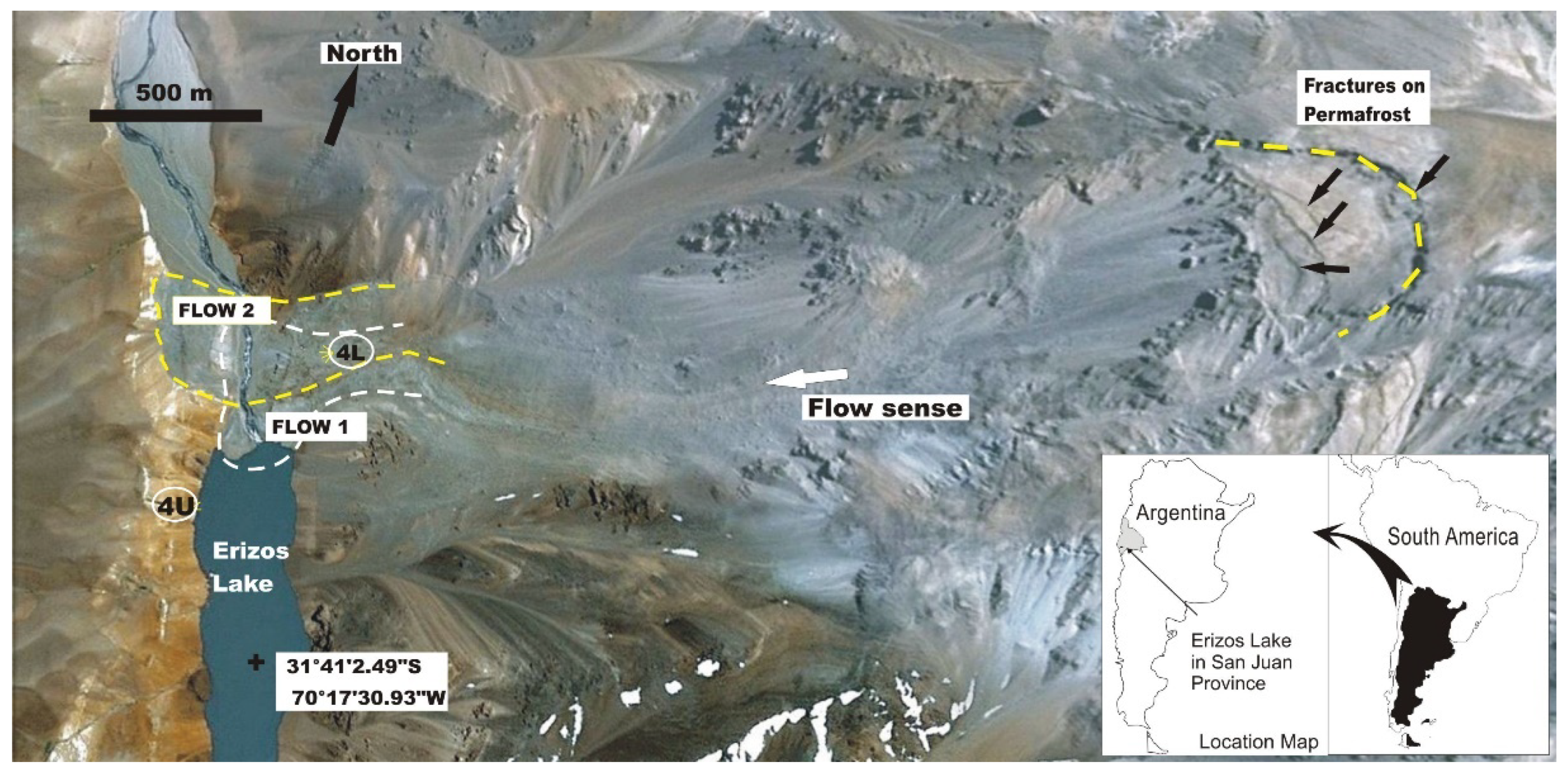

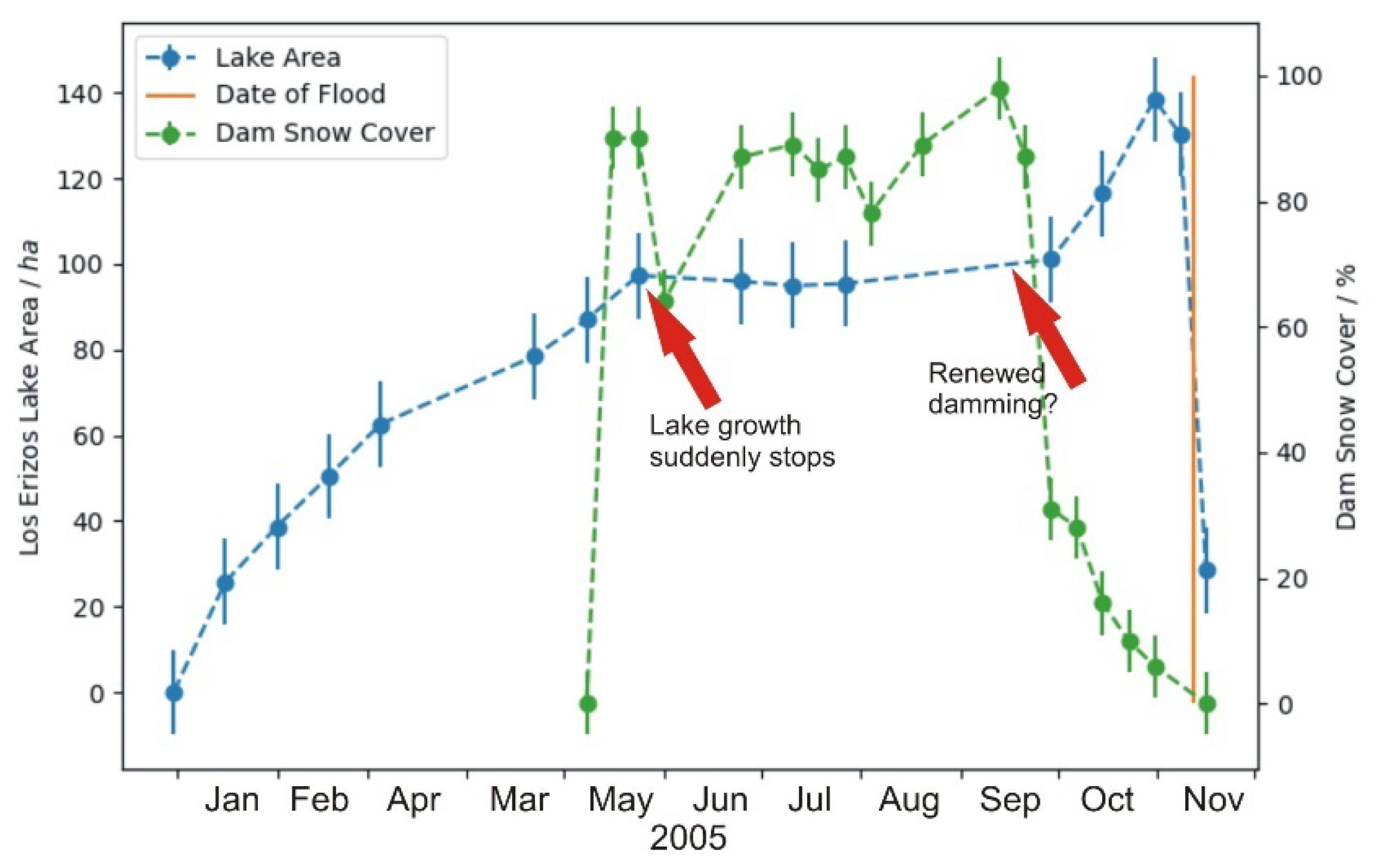

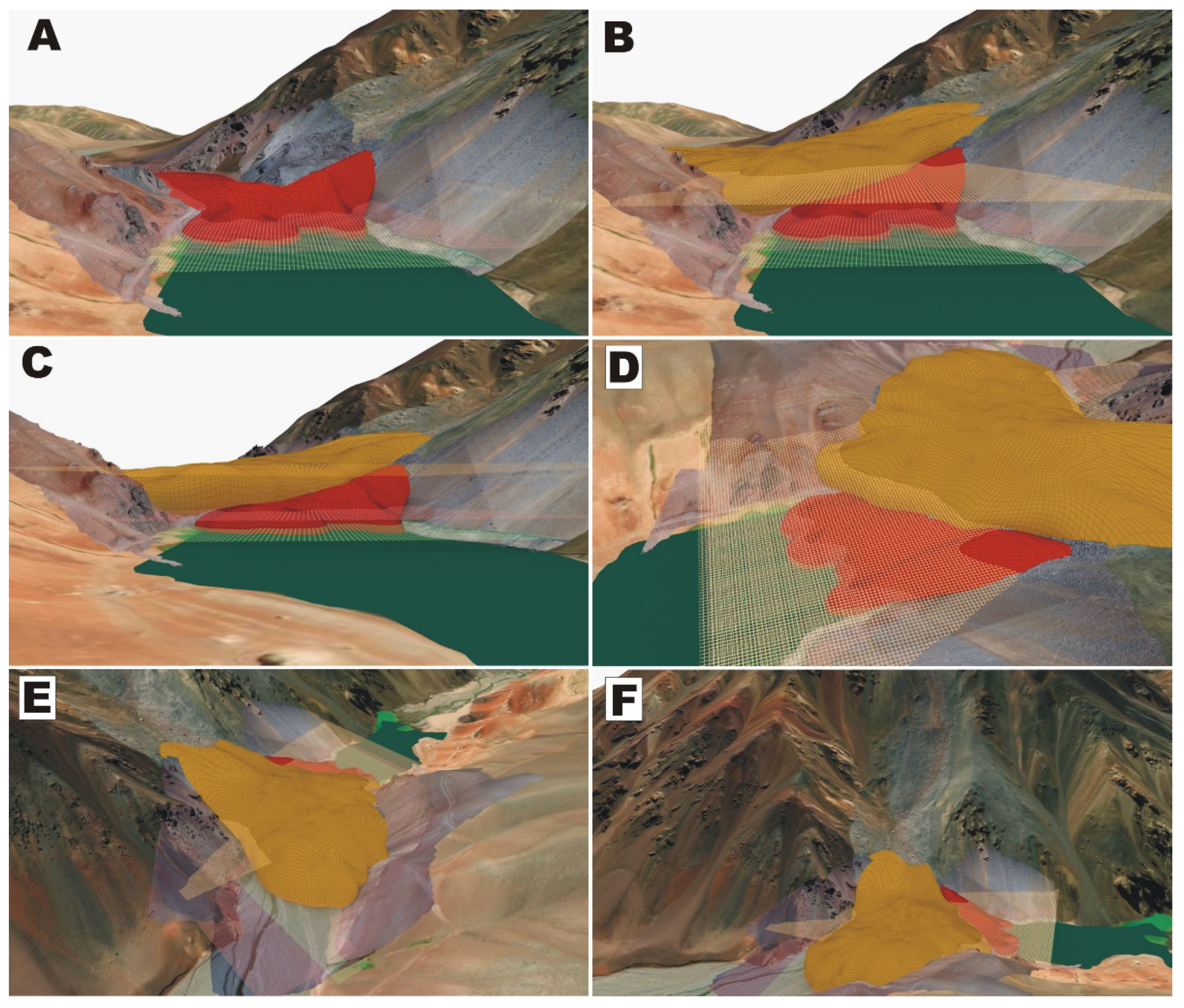

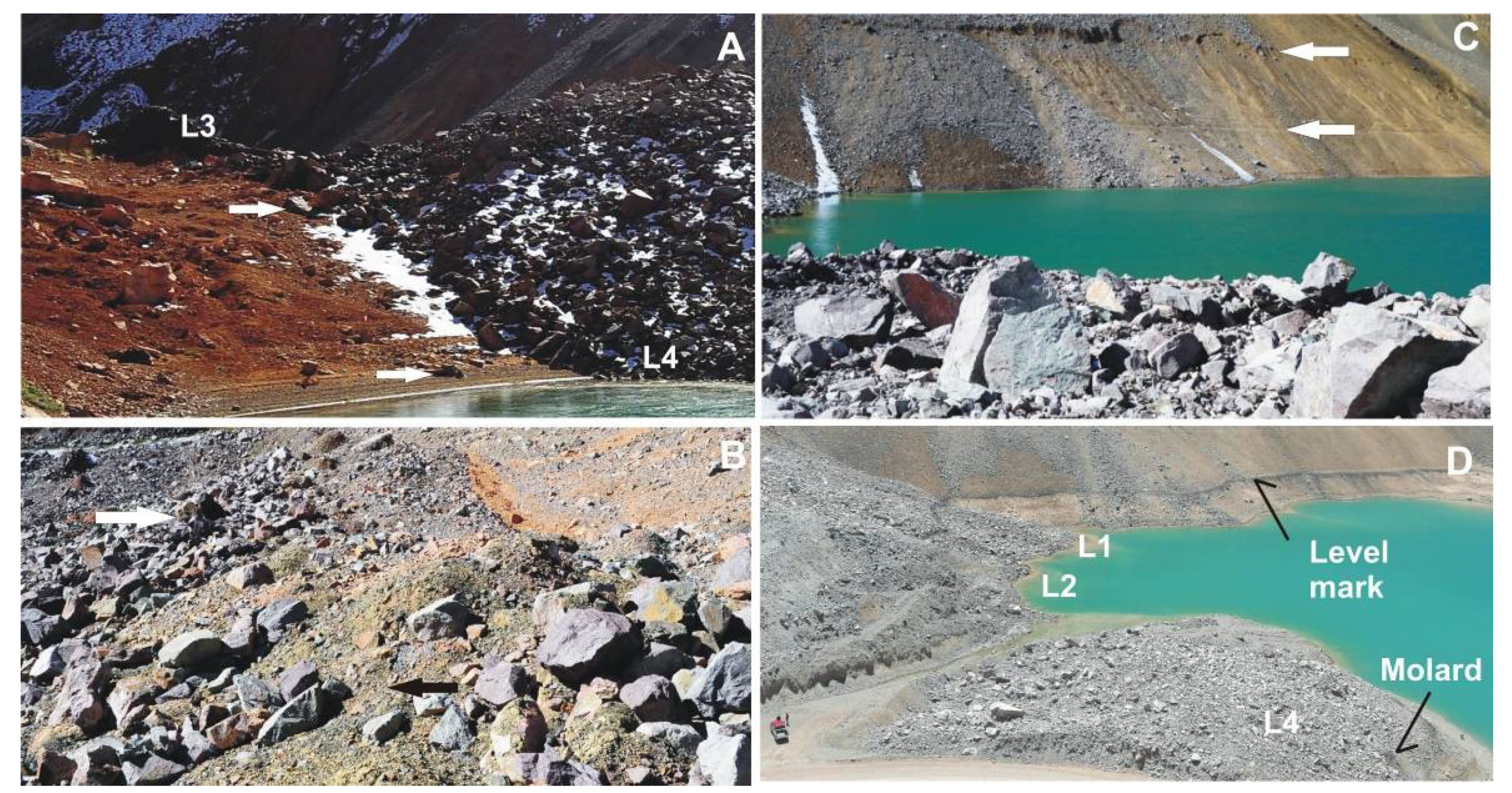
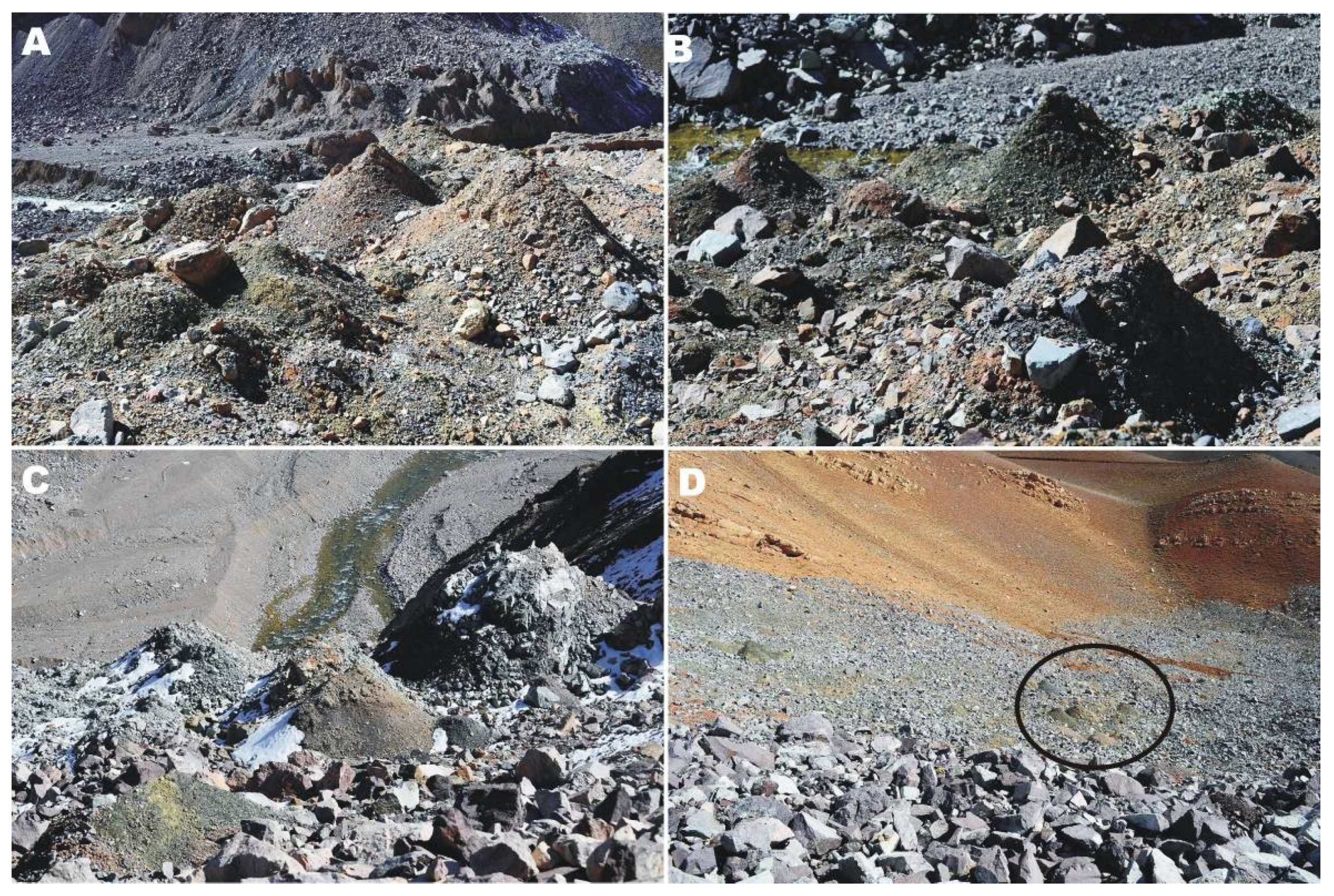
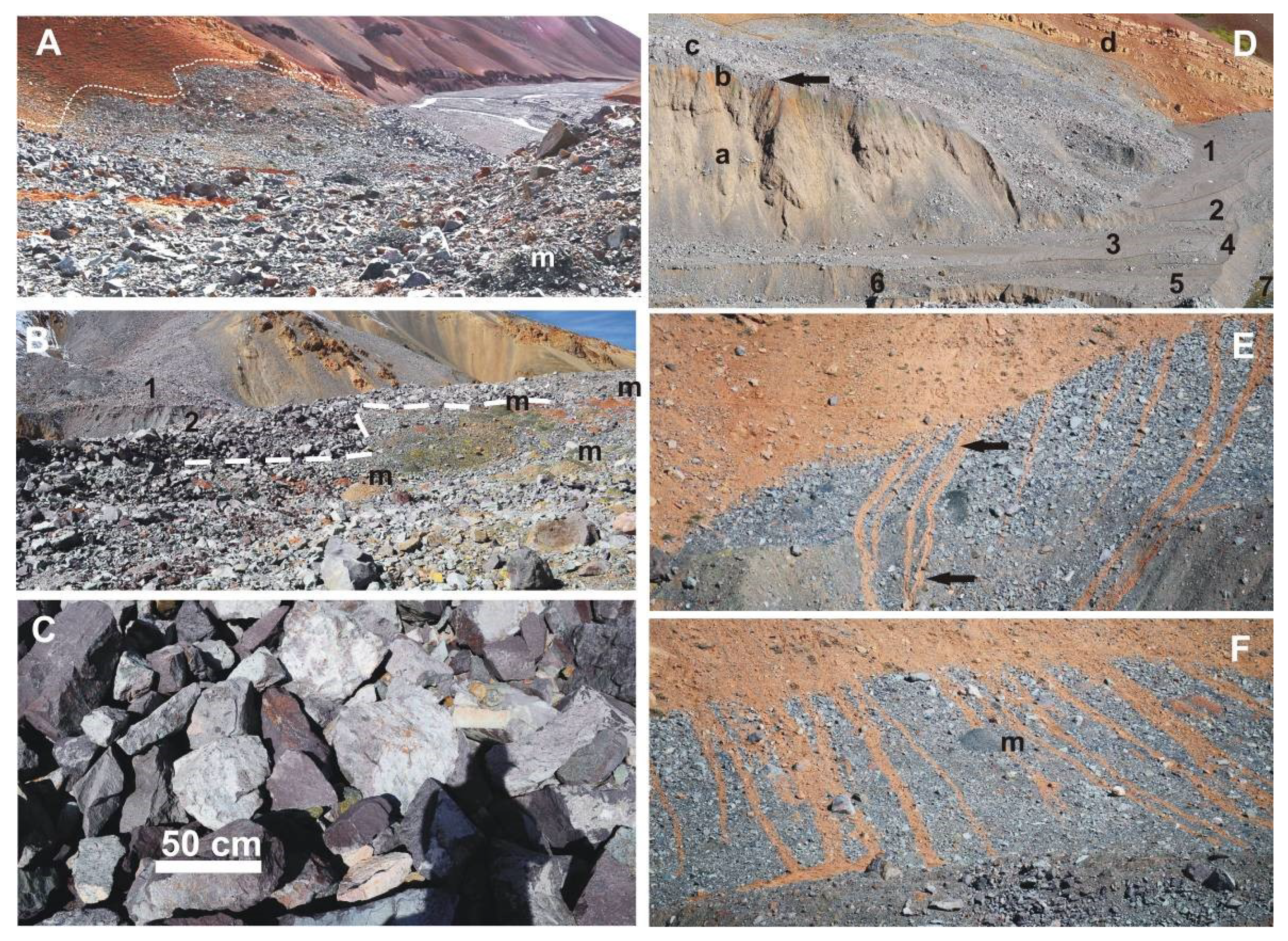
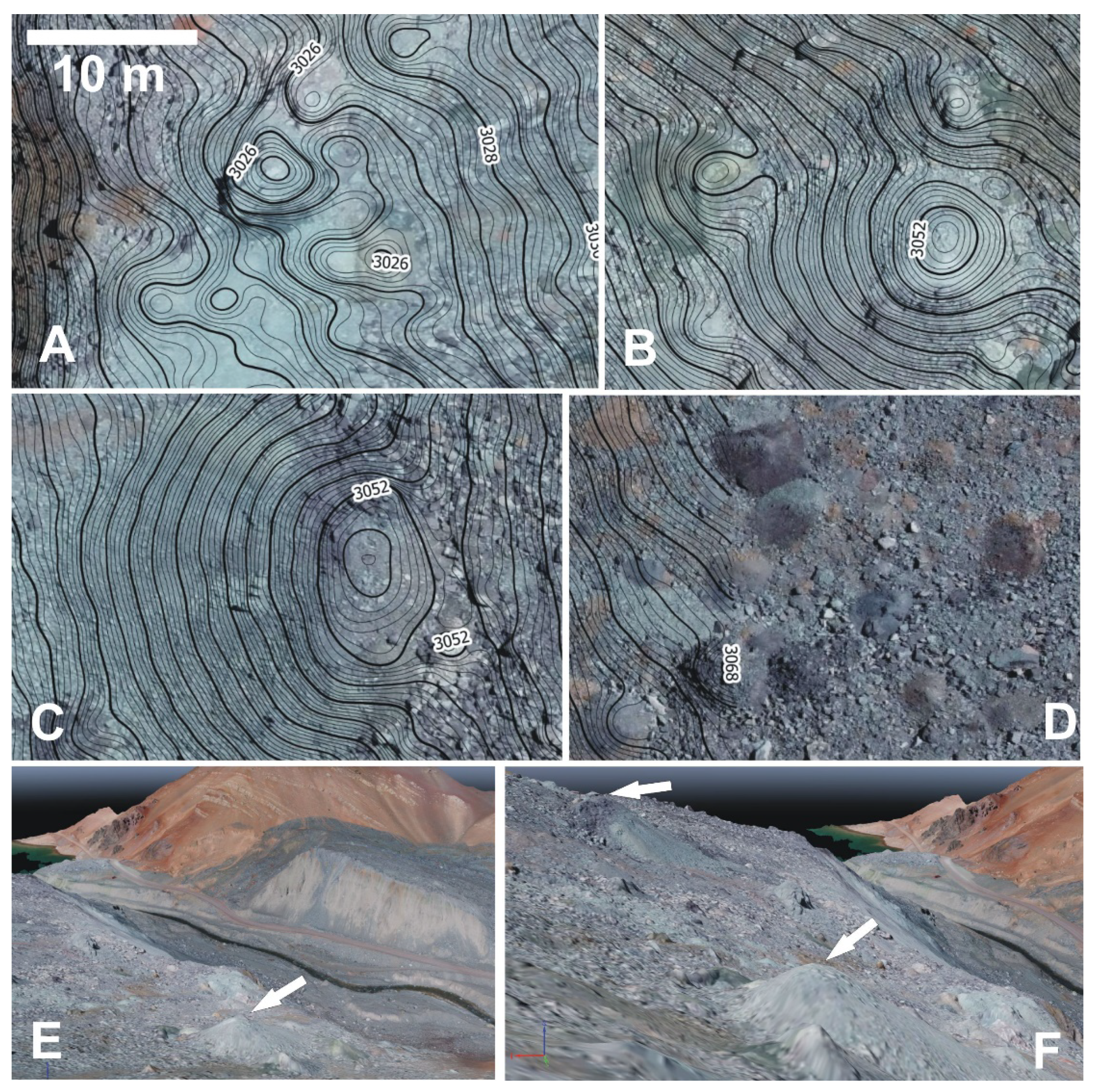

| Point on Figure 2 | Feature Mentioned in the Text | Altitude m.a.s.l. |
|---|---|---|
| 1 | Valley floor before closure at the dam centre | 2940 |
| 2 | Highest flood terrace at canyon exit | 2950 |
| 3 | Lowest flood terrace at canyon exit | 2944 |
| 4 | Observed closure of Flow 1 | 2968 |
| 5 | Lake level intermediate mark | 2972 |
| 6 | Observed closure of Flow 2 | 3009 |
| 7 | Lake level highest mark | 3007 |
| 8 | Lake level after flood | 2957 |
| 9 | Lake level today | 2949 |
Publisher’s Note: MDPI stays neutral with regard to jurisdictional claims in published maps and institutional affiliations. |
© 2022 by the authors. Licensee MDPI, Basel, Switzerland. This article is an open access article distributed under the terms and conditions of the Creative Commons Attribution (CC BY) license (https://creativecommons.org/licenses/by/4.0/).
Share and Cite
Milana, J.P.; Geisler, P. Forensic Geology Applied to Decipher the Landslide Dam Collapse and Outburst Flood of the Santa Cruz River (12 November 2005), San Juan, Argentina. GeoHazards 2022, 3, 252-276. https://doi.org/10.3390/geohazards3020014
Milana JP, Geisler P. Forensic Geology Applied to Decipher the Landslide Dam Collapse and Outburst Flood of the Santa Cruz River (12 November 2005), San Juan, Argentina. GeoHazards. 2022; 3(2):252-276. https://doi.org/10.3390/geohazards3020014
Chicago/Turabian StyleMilana, Juan Pablo, and Philipp Geisler. 2022. "Forensic Geology Applied to Decipher the Landslide Dam Collapse and Outburst Flood of the Santa Cruz River (12 November 2005), San Juan, Argentina" GeoHazards 3, no. 2: 252-276. https://doi.org/10.3390/geohazards3020014
APA StyleMilana, J. P., & Geisler, P. (2022). Forensic Geology Applied to Decipher the Landslide Dam Collapse and Outburst Flood of the Santa Cruz River (12 November 2005), San Juan, Argentina. GeoHazards, 3(2), 252-276. https://doi.org/10.3390/geohazards3020014






